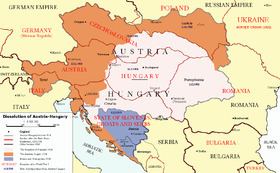Signed 10 September 1919 Date 10 September 1919 | Effective 16 July 1920 | |
 | ||
Signatories Austria British Empire France Italy Japan Serbia United StatesOther Allied Powers Belgium China Cuba Czechoslovakia Greece Nicaragua Panama Poland Portugal Romania Siam Location Château de Saint-Germain-en-Laye, Saint-Germain-en-Laye, France | ||
The Treaty of Saint-Germain-en-Laye was signed on 10 September 1919 by the victorious Allies of World War I on the one hand and by the Republic of German-Austria on the other. Like the Treaty of Trianon with Hungary and the Treaty of Versailles with Germany, it contained the Covenant of the League of Nations and as a result was not ratified by the United States but was followed by the US–Austrian Peace Treaty of 1921.
Contents
The treaty signing ceremony took place at the Château de Saint-Germain-en-Laye.
Background
Already on 21 October 1918, 208 German-speaking delegates of the Austrian Imperial Council had convened in a "provisional national assembly of German-Austria " at the Lower Austrian Landtag. While the collapse of the Austro-Hungarian Army culminated at the Battle of Vittorio Veneto, the Social Democrat Karl Renner was elected German-Austrian State Chancellor on 30 October. In the course of the Aster Revolution on 31 October, the newly established Democratic Republic of Hungary under Minister President Mihály Károlyi declared the real union with Austria terminated.
With the Armistice of Villa Giusti on 3 November 1918, the fate of the Austro-Hungarian Monarchy was sealed. On 11 November 1918 Emperor Charles I of Austria officially declared to "relinquish every participation in the administration", one day later the provisional assembly declared German-Austria a democratic republic and part of the German Republic. However, on the territory of the Cisleithanian ("Austrian") half of the former empire, the newly established states of Czechoslovakia, Poland, and the Yugoslav Kingdom of Serbs, Croats and Slovenes (the "successor states") had been proclaimed. Moreover, South Tyrol and Trentino were occupied by Italian forces and Yugoslav troops entered the former Duchy of Carinthia, leading to violent fights.
An Austrian Constitutional Assembly election was held on 16 February 1919. The Assembly re-elected Karl Renner state chancellor and enacted the Habsburg Law concerning the banishment of the House of Lorraine. When Chancellor Renner arrived at Saint-Germain in May 1919, he and the Austrian delegation found themselves excluded from the negotiations led by French Prime Minister Georges Clemenceau. Upon an Allied ultimatum, Renner signed the treaty on 10 September. The Treaty of Trianon in June 1920 between Hungary and the Allies completed the disposition of the former Dual Monarchy.
Provisions
The treaty declared that the Austro-Hungarian Empire was to be dissolved. According to article 177, the Austrian side accepted responsibility for causing the war along with the Central Powers. The new Republic of Austria, consisting of most of the German-speaking Danubian and Alpine provinces in former Cisleithania, recognized the independence of Hungary, Czechoslovakia, Poland, and the Kingdom of Serbs, Croats and Slovenes. The treaty included 'war reparations' of large sums of money, directed towards the Allies.
Territory
Cisleithanian Austria had to face significant territorial losses, amounting to over 60 percent of the prewar Austrian Empire's territory:
Burgenland, i.e. the predominantly German-speaking western parts of the Hungarian counties of Moson, Sopron and Vas, were awarded to Austria. The affiliation of the Southern Carinthian territory with its Slovene-speaking share of population was to be decided in a Carinthian Plebiscite.
In nearly all of these cases, the Allies not only assumed without question that the minority peoples wanted to leave Austria, but allowed the successor states to absorb significant blocks of German-speaking territory.
Politics and military
Article 88 of the treaty required Austria to refrain from directly or indirectly compromising its independence, which meant that Austria could not enter into political or economic union with the German Reich without the agreement of the council of the League of Nations. Accordingly, the new republic's initial self-chosen name of German-Austria (German: Deutschösterreich) had to be changed to Austria. Many Austrians would come to find this term harsh (especially among the Austrian Germans who were German nationalists of the former Austro-Hungarian Empire), due to Austria's later economic weakness, which was caused by loss of land. The economic weakness of Austria would later lead to support for the idea of Anschluss (political union) with Nazi Germany.
Conscription was abolished and the Austrian Army was limited to a force of 30,000 volunteers. There were numerous provisions dealing with Danubian navigation, the transfer of railways, and other details involved in the breakup of a great empire into several small independent states.
The vast reduction of population, territory and resources of the new Austria relative to the old empire wreaked havoc on the economy of the old nation, most notably in Vienna, an imperial capital now without an empire to support it. For a time, the country's very unity was called into question. Unlike its former Hungarian partner, Austria had never been a nation in the true sense of the word. While the Austrian state had existed in one form or another for over 700 years, it had no unifying force other than loyalty to the Habsburgs.
